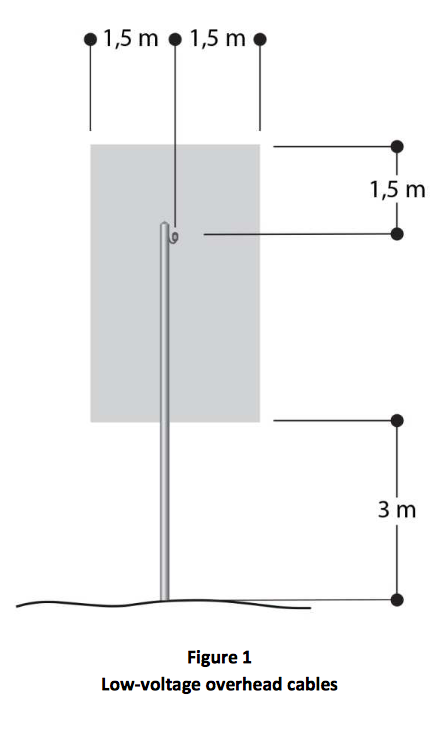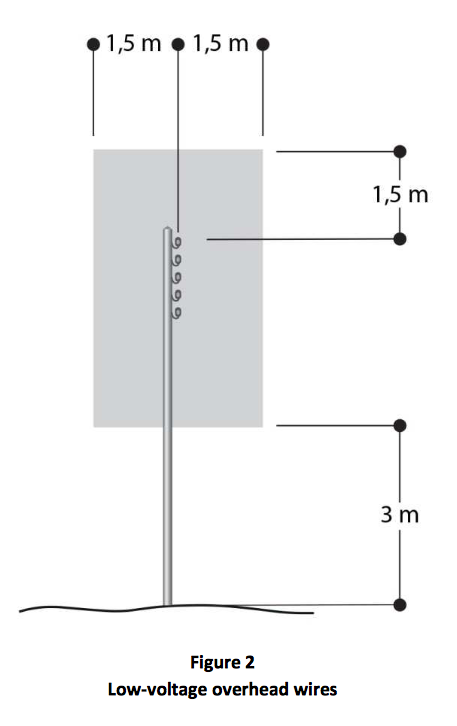In any case of misinterpretation between the translated version and the Danish version, the Danish version has legal force.
(Executive order no. 1112 from August 18th, 2016)
In pursuance of Section 5(1)(iv) and Section 34(2) of the Danish Act No. 525 of 29 April 2015 on the Safety of Electrical Plants, Electrical Installations and Electrical Equipment (the Electrical Safety Act), the following is laid down:
Executive Order: Work near electricity
Part 1: Scope and definitions
Scope
1(1). This Executive Order applies to non-electrical work performed for private or commercial purposes in the vicinity of electrical plants.
(2). This Executive Order does not apply to:
i) work performed by or under the management of an operating company for an electrical plant;
ii) work performed in accordance with an agreement with an operating company for an electrical plant under Part 8 of the Executive Order on Safety in connection with the Operation of Electrical Plants.
iii) private individuals’ ordinary gardening and soil cultivation activities or
iv) transport and ordinary traffic on public roads.
Definitions
2. The following definitions are used in this Executive Order:
i) Marking or cover material for buried cables: Material placed above cables in the ground to warn of the location of the buried cable with the purpose to avoiding mechanical damage by digging.
ii) Contractor: Any person or company who performs or has its staff perform construction work, road work, agricultural work, machine pool work or the like, including transport.
iii) High-voltage plant: Electrical plant with a nominal voltage in excess of 1000V a.c. or 1500V d.c.
iv) In the vicinity of: Work involving a danger of not observing the stipulated minimum distances.
v) Buried cable: Cable placed in the ground and consisting of bare conductors or one or more insulated conductors surrounded by an exterior sheath.
vi) Cable distribution cabinet: Cabinet or the like for connecting underground cables above ground.
vii) Cable box. Box for connecting buried cables underground.
viii) Low-voltage plant: Electrical plant with a nominal voltage up to and including 1000V a.c. or 1500V d.c.
ix) Overhead wire: Wire with two or more separate conductors suspended from pylons.
x) Overhead cable: Insulated conductors intertwined into a cable suspended from pylons.
xi) Minimum distance: Distance stipulated in order to provide adequate safety in connection with work in the vicinity of electrical plants or parts thereof. Figures 1-5 in Appendix 1 show the minimum distances as grey-tone areas. Minimum distances to railway systems are stipulated in the safety instructions issued by the infrastructure manager.
xii) Site plan: A description of the site and the scope of the work.
Part 2: The contractor's duties
3. The contractor is required to
i. obtain line information prior to commencing any pit, digging, drilling or driving-in work;
ii. forward a site plan describing the extent of the work to the owner of the electrical plant in case of large works prior to commencing such work;
iii. follow directions from the owner of the electrical plant and
iv. notify the owner of the electrical plant of any damage, incident and accident in connection with the execution of work in the vicinity of an electrical plant.
4. The contractor is required to instruct and inform its staff who will be working in the vicinity of the electrical plants about
i. the location of the electrical plant;
ii. the provisions of this Executive Order;
iii. directions from the owner of the electrical plant and
iv. the name and contact information of the owner of the electrical plant.
Part 3: Work in the vicinity of overhead wires, overhead cables and sub-stations
5(1). In case of work in the vicinity of overhead wires and overhead cables the horizontal minimum distance, cf. subsection (2) below, and the vertical minimum distances, cf. subsection (3), must be observed, cf. however subsections (4)-(5) and Section 6 below.
(2). The horizontal minimum distance is 3 metres from the ground, cf. Appendix 1, Figures 1-4.
(3). The vertical minimum distances are
i. 1.5 metres from the outermost conductor for low-voltage overhead wires and low-voltage overhead cables, cf. Appendix 1, Figures 1-2;
ii. 6 metres from the outermost conductor for high-voltage overhead wires between 10-40kV, cf. Appendix 1, Figure 3 and
iii. 15 metres from the outermost conductor for high-voltage overhead wires exceeding 40kV, cf. Appendix 1, Figure 4.
(4). Driving or using agricultural machines is not covered by subsection (1) above if the height of the machine, including persons on the machine, does not exceed
i. 4 metres in case of low-voltage electrical plants and
ii. 4.5 metres in case of high-voltage electrical plants.
(5). If the agricultural machine is equipped with movable parts that may exceed the maximum height stipulated in subsection (4) above, it must be ensured that the movable parts are locked in place during driving or use of the agricultural machine so that the maximum height is not exceeded.
6. If it is not possible to perform work while observing the minimum distances stipulated in Section 5 above, detailed instructions about how to perform the work must be obtained from the owner of the electrical plant.
7. Work may be performed above low-voltage overhead wires and low-voltage overhead cables on the condition that the minimum distance of 1.5 metres above the wire is observed, cf. Appendix 1, Figures 1-2.
8. Depositing of excavated or removed material under overhead wires within the horizontal minimum distances may only take place according to agreement with the owner of the electrical plant.
9. Excavation may not be performed in such close vicinity to pylons or transformer stations that there is a risk that they may topple over or skid.
10(1). Irrigators or parts thereof that may pose a touch hazard when spraying on high-voltage overhead wires must be provided with clearly visible and durable warning signs.
(2). Warning signs, cf. subsection (1) above, must be in compliance with the Executive Order on Safety Signs and Other Forms of Signalling.
Part 4: Work in the vicinity of buried cables
11(1). In case of work in the vicinity of buried cables with associated cable distribution cabinets and cable boxes, the work must be planned so that damage is avoided.
(2). Directions for the performance of the work must be obtained from the owner of the electrical plant in the following cases:
i. For underground work within the minimum distance of 1 metre from the buried cable, cf. Appendix 1, Figure 5.
ii. When digging free buried cables.
iii. In case there is a risk of mechanical damage to a dug free buried cable.
(3). In case of ordinary soil cultivation work in connection with gardening or agricultural activities, subsections (1)-(2)shall not apply.
12. Depositing of material above buried high voltage cables may only take place according to agreement with the owner of the electrical plant.
13. Marking and cover material for underground cables may not be removed or moved without the permission of the owner of the electrical plant.
Part 5: Precatutions in case of accidents
14(1). An electrical plant must be regarded as live, unless the owner of the electrical plant has declared that the plant is dead.
(2). If an object has come into contact with an electrical plant or a flashover has occurred, the object shall be regarded as live.
15. The following minimum distances must be observed in the vicinity of live objects, fallen-down wires or damaged cables:
i. 10 metres in case of high-voltage electrical plants.
ii. 2 metres in case of low-voltage electrical plants.
16(1). In case of an accident or injury, the contractor or its staff must notify the owner of the electrical plant of the following as soon as possible:
i. The place where the accident or injury took place.
ii. A description of the accident or injury.
(2). The contractor and its staff must, until the owner of the electrical plant, its representative or the police have arrived on site,
i. keep guard onsite and
ii. make sure that people are warned of the danger and the minimum distances, cf. Section 15.
Part 6: Penalty
17(1). Unless a higher penalty is incurred in pursuance of other legislation, anyone who fails to observe Sections 3-10, Section 11(2), Sections 12-13 and Sections 15-16 shall be liable to a fine.
(2). Companies etc. (legal persons) may incur criminal liability in pursuance of the rules of Part 5 of the Criminal Code.
Part 7: Entry into force
18(1). This Executive Order comes into force on 1 July 2017.
(2). At the same time, the Executive Order of 1 May 1994 on the Heavy Current Regulation Section 5A, Safety Regulations for construction work, road work, agricultural work etc. in the vicinity of electricity supply plants shall be repealed.







